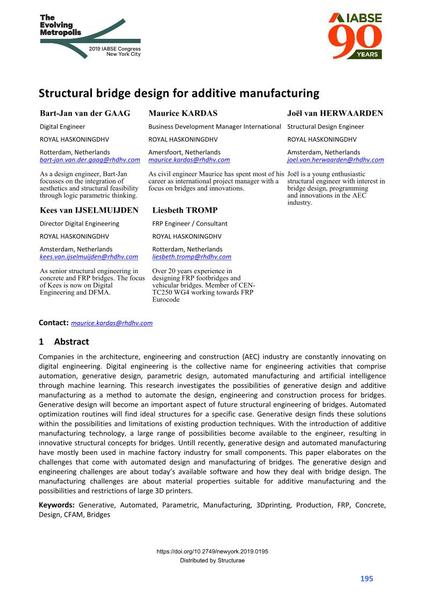Structural bridge design for additive manufacturing

|
|
|||||||||||
Bibliographic Details
| Author(s): |
Bert-Jan van der Gaag
(ROYAL HASKONINGDHV)
Maurice Kardas (ROYAL HASKONINGDHV) Joël van HERWAARDEN (ROYAL HASKONINGDHV) Kees Van Ijselmuijden (ROYAL HASKONINGDHV) Liesbeth Tromp (ROYAL HASKONINGDHV) |
||||
|---|---|---|---|---|---|
| Medium: | conference paper | ||||
| Language(s): | English | ||||
| Conference: | IABSE Congress: The Evolving Metropolis, New York, NY, USA, 4-6 September 2019 | ||||
| Published in: | The Evolving Metropolis | ||||
|
|||||
| Page(s): | 195-199 | ||||
| Total no. of pages: | 5 | ||||
| DOI: | 10.2749/newyork.2019.0195 | ||||
| Abstract: |
Companies in the architecture, engineering and construction (AEC) industry are constantly innovating on digital engineering. Digital engineering is the collective name for engineering activities that comprise automation, generative design, parametric design, automated manufacturing and artificial intelligence through machine learning. This research investigates the possibilities of generative design and additive manufacturing as a method to automate the design, engineering and construction process for bridges. Generative design will become an important aspect of future structural engineering of bridges. Automated optimization routines will find ideal structures for a specific case. Generative design finds these solutions within the possibilities and limitations of existing production techniques. With the introduction of additive manufacturing technology, a large range of possibilities become available to the engineer, resulting in innovative structural concepts for bridges. Untill recently, generative design and automated manufacturing have mostly been used in machine factory industry for small components. This paper elaborates on the challenges that come with automated design and manufacturing of bridges. The generative design and engineering challenges are about today’s available software and how they deal with bridge design. The manufacturing challenges are about material properties suitable for additive manufacturing and the possibilities and restrictions of large 3D printers. |
||||
| Keywords: |
design concrete bridges FRP production manufacturing 3D printing automated Generative Parametric CFAM
|
||||
